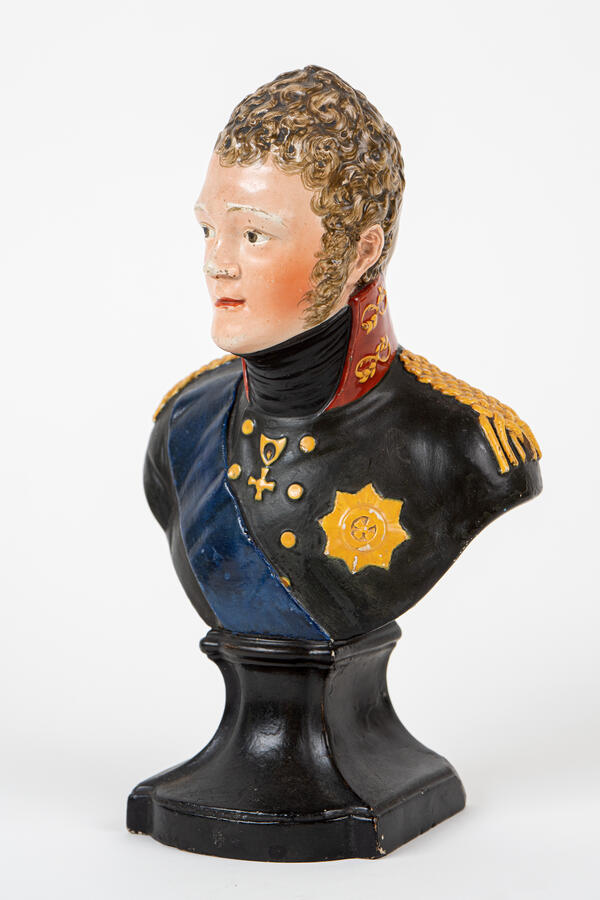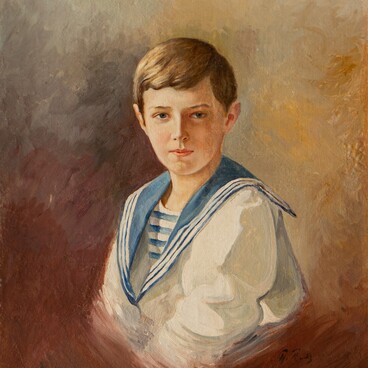The bust of Emperor Alexander I, made at Enoch Wood’s factory in the early 19th century, is part of the collection of the Tsarskoe Selo State Museum and Heritage Site.
This bust was in the Alexander Palace, where the tables and consoles of the Corner Drawing Room housed commemorative ceramic, marble and bronze pieces made by foreign and Russian manufacturers, including Staffordshire ceramic busts of Alexander I, the first owner of the palace.
The ceramic bust is a polychrome-painted chest-length image of Emperor Alexander I on a sculptural pedestal. The tsar is dressed in the uniform of the Life-Guards Preobrazhensky Regiment, one of the most elite military units of the Russian Empire. On his chest, the emperor has two orders: the Order of St Andrew and the Order of St George fourth class.
The Staffordshire Potteries was an industrial area encompassing six towns in England: Burslem, Fenton, Hanley, Longton, Stoke and Tunstall. North Staffordshire became a center of ceramic production in the early 17th century due to the local sufficient availability of clay and coal. Hundreds of factories produced all kinds of pottery — from tableware and decorative pieces to industrial items. The Staffordshire industry was a major innovator in developing new varieties of pottery and porcelain, such as bone china, as well as transfer printing.
One of the leading pottery makers was Enoch Wood (1759–1840), an English potter who came from an influential family of Staffordshire ceramists. Wood studied drawing in Liverpool, then was apprenticed to a well-known potter in Hanley. He started out as a fashion designer and established a successful factory in Burslem, trading as Wood and Caldwell. In the 18th century, the factory produced a large number of figurines as well as other types of ceramics and earthenware that Wood modeled himself. After 1818, when Enoch Wood’s sons became partners, the company was renamed Enoch Wood & Sons. The firm produced blue and white transfer printed earthenware, most of which was exported to America.
This bust was in the Alexander Palace, where the tables and consoles of the Corner Drawing Room housed commemorative ceramic, marble and bronze pieces made by foreign and Russian manufacturers, including Staffordshire ceramic busts of Alexander I, the first owner of the palace.
The ceramic bust is a polychrome-painted chest-length image of Emperor Alexander I on a sculptural pedestal. The tsar is dressed in the uniform of the Life-Guards Preobrazhensky Regiment, one of the most elite military units of the Russian Empire. On his chest, the emperor has two orders: the Order of St Andrew and the Order of St George fourth class.
The Staffordshire Potteries was an industrial area encompassing six towns in England: Burslem, Fenton, Hanley, Longton, Stoke and Tunstall. North Staffordshire became a center of ceramic production in the early 17th century due to the local sufficient availability of clay and coal. Hundreds of factories produced all kinds of pottery — from tableware and decorative pieces to industrial items. The Staffordshire industry was a major innovator in developing new varieties of pottery and porcelain, such as bone china, as well as transfer printing.
One of the leading pottery makers was Enoch Wood (1759–1840), an English potter who came from an influential family of Staffordshire ceramists. Wood studied drawing in Liverpool, then was apprenticed to a well-known potter in Hanley. He started out as a fashion designer and established a successful factory in Burslem, trading as Wood and Caldwell. In the 18th century, the factory produced a large number of figurines as well as other types of ceramics and earthenware that Wood modeled himself. After 1818, when Enoch Wood’s sons became partners, the company was renamed Enoch Wood & Sons. The firm produced blue and white transfer printed earthenware, most of which was exported to America.




